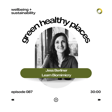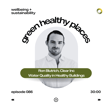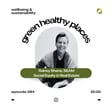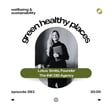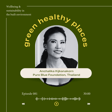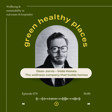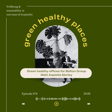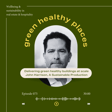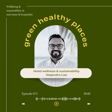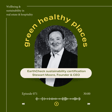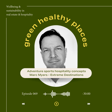Become a Creator today!Start creating today - Share your story with the world!
Start for free
00:00:00
00:00:01

078: An ancestral perspective on real estate, Matt Morley
How can evolutionary history provide insight into building better buildings today for the generations to follow? What lessons can real estate professionals take from evolutionary psychology and anthropology to ensure cross-generational karma? Here I discuss Indoor Air Quality, Healthy Materials, Biophilic Design, Active Design and Restorative Spaces - all evolution friendly design adaptations for modern buildings.
Transcript
Designing Buildings as Good Ancestors
00:00:13
Speaker
Welcome to episode 78 of the Green Healthy Places podcast, in which we discuss the themes of wellbeing and sustainability in real estate and hospitality. This episode is going a little differently. It's inspired by a recent TED Talk I was asked to give in London. The title is Designing Buildings Like a Good Ancestor.
Evolutionary Insights in Building Design
00:00:41
Speaker
Evolutionary history helps explain our innate connection to music and dance, need for social bonding, our penchant for salty and sweet foods, even our empathy for certain four-legged friends. And that kind of zoomed out, deep-time perspective can, I believe, also provide a surprising amount of guidance on how to build better buildings today for the generations to follow.
00:01:11
Speaker
Those responsible for our built environment can, in other words, make targeted design decisions influenced by evolutionary psychology and anthropology to ensure cross-generational karma.
Focus on Decarbonization and Wellbeing
00:01:25
Speaker
So really, this is how I feed my hero complex by helping residential real estate developers, hoteliers, and offices to create places and spaces that are healthy for people and planet.
00:01:39
Speaker
and in addition to urgent decarbonisation for planetary health. Right now, that means answering specific human health concerns as well, such as non-toxic building materials, enhanced indoor air quality, maintaining a connection to nature indoors or biophilia, and designing interiors for physical activity and mental wellbeing.
Roles and Personal Inclinations in Design
00:02:03
Speaker
No matter where we are on the evolutionary timeline,
00:02:06
Speaker
In any society, be it tribal or post-industrial, some of us are drawn to child rearing, others to trading goods and services, or caring for the sick, preparing food, or passing on accumulated wisdom, while some, like me, feel a gravitational pull towards the physical structures that we inherit, build, and ultimately leave behind. And so, now that I have you gathered around this
00:02:37
Speaker
high-tech online campfire, let me tell you our story.
Sustainable Materials and Health Risks
00:02:42
Speaker
And we begin with the materials that go into building construction and interiors. Because if we get that bit wrong, those elements alone can be responsible for habitat loss, resource depletion, and environmental damage even before the first foundation is laid.
00:02:58
Speaker
So to prevent that, we want less fossil fuel-based plastics in our flooring, more sustainable timber, more locally sourced recycled and bio-based materials. Yet at the same time, on the human side, we are still playing whack-a-mole with a plethora of chemicals of concern that quietly crept into our man-made building materials after the 19th century's chemical revolution.
00:03:24
Speaker
Think of asbestos formaldehyde in lead or more recently flame retardants, antimicrobials and chemical off gases known as volatile organic compounds or VOCs. The issue here is low grade piping, insulation, furniture, flooring, finishes, paints and adhesives that previous generations inadvertently buried in our buildings, leaving behind a toxic inheritance.
Choosing Safe Building Materials
00:03:51
Speaker
If allowed to accumulate indoors,
00:03:53
Speaker
Those substances can variously cause hormone disruption, cancer, respiratory problems, and cognitive dysfunction. Stakes are high. So how do we avoid making similar mistakes in our new buildings and refurbishments? As a first pass, when I'm looking at a fit-out materials list, I use the great-great-grandparent test. Would they have recognized a given material or not?
00:04:20
Speaker
If not, I know I need to push the manufacturer for what's called the product declaration, showing exactly what's in it, essentially like a material ingredient list, so that I have some visibility on the possible health risks to people or indeed planet. From there, going a level deeper, we deploy a lifecycle analysis to check how a material was extracted, what went into the manufacturing process,
00:04:47
Speaker
how it degrades or breaks down over time while in use, as well as the options that exist for its reuse at the end of life.
Long-term Mindset in Building Design
00:04:56
Speaker
And thirdly, the precautionary principle. So if I'm in real doubt about a specific material, the responsible thing to do is leave it out, especially when dealing with a large volume order. For example, the choice of flooring in a 1,000 unit residential tower.
00:05:15
Speaker
So those three tools combined help ensure the materials going into a building are not creating an unhealthy indoor environment or causing damage to the natural world. And of course, buildings just like the materials that go into them have their own life cycle, from planning to design, construction, operation, and in some cases eventual demolition.
00:05:40
Speaker
Although, interestingly, if you adopt a 100-year or even a 1000-year mindset in phases 1 to 3, so planning, design and construction, you can effectively delay demolition indefinitely, which means less waste, less carbon impact, and more chance of somebody making it into Wikipedia. So that in-use phase can basically extend on and on.
00:06:06
Speaker
Our work continues in that part of the process then to make an indoor environment as healthy as possible. Even
Ensuring Healthy Indoor Air Quality
00:06:15
Speaker
before COVID came along, as part of a healthy building plan, we knew that we needed to increase indoor ventilation rates, basically circulating the air in a closed indoor space more often per hour to refresh it.
00:06:29
Speaker
We knew we needed to be upgrading air conditioning unit filters to catch the smallest airborne particles and off gases. And we needed to install air quality monitors that help us see the air quality in real time and identify issues as they happen rather than trying to fix them after the fact.
00:06:50
Speaker
Combined with the materials policy mentioned earlier, these initiatives around air quality should give us something close to an equivalent of green, healthy indoor air. This may be not as good as self-isolating in a forest treehouse, but clearly is a solution designed for urban living.
00:07:11
Speaker
And when we start prioritising non-toxic natural materials in our interiors and buildings such as wood, stone, cork, wool insulation, rammed earth finishes or lime plaster and clay, they automatically bring an organic aesthetic back into our buildings right when our dense urban environments feel increasingly disconnected from the natural world that we evolved in.
Biophilic Design in Urban Spaces
00:07:39
Speaker
Only recently, with what is known as biophilia, are architects and designers rekindling that connection with nature by reintroducing elements of the wild back into our built environment in what equates to an aesthetic crossbreed, part indoor, part outdoor. Biophilic design is really just a butterfly emerging from its cocoon in design terms. It's been right there all along, simply waiting for its moment.
00:08:10
Speaker
And so we fill our interiors with all those natural materials and finishes, as well as living plants, vertical gardens, hydroponics. We can deploy indirect representations of nature too, such as color palettes, fractal patterns, organic textures and shapes, but also sounds, sense, even smart lighting to replicate the ebb and flow of sunlight.
00:08:39
Speaker
In one of two research studies I worked on with a team at the University of Essex, after just 30 to 60 mindful minutes in a biophilic space, 74% of respondents felt an improvement in mood, 84% felt more productive and 87% reported lower levels of perceived stress.
00:09:03
Speaker
So a space loaded with vitamin nature like that one can provide enough sensory continuity with the natural world to trigger many of the same mental health benefits as our brain on actual nature, at least until that next jog by the river.
Benefits of Exercising in Natural Environments
00:09:21
Speaker
which is where the tail takes another twist. Because green exercise or exercising outdoors means you get all the mental health benefits of being fully immersed in nature as well as the physical benefits of movement and exertion. Green exercise is like exercise squared.
00:09:42
Speaker
And if a hardworking post-grad student at a medical university in Stockholm that I work with can't get outside in their break because it's a snowy minus five outside, a biophilic design intervention can provide a solution.
00:09:58
Speaker
We converted an underutilised waiting area of just 25 square metres into a forest-themed fitness room using sustainable, non-toxic materials with functional fitness equipment for small group training sessions. And this was accessible to all staff and students. So why did one of the world's leading medical universities brief me to do that?
00:10:21
Speaker
Because the right dose of exercise has been proven to boost productivity and concentration, reduce anxiety, enhance feelings of self-esteem, and even improve mood. In other words, those around us benefit indirectly too, whether that be an employer or a university, in this case.
Modern Lifestyles vs. Evolutionary Past
00:10:43
Speaker
But I'm really not here to sell exercise.
00:10:47
Speaker
Not all of us were born to run. In fact, our ancient instinct is to conserve energy and avoid unnecessary exertion. There is a catch, however, because from a deep time perspective, calories were generally scarce.
00:11:06
Speaker
So several hours of daily movement, be that hunting or gathering, were required to procure even a minimum calorie intake. It was the birth of agriculture and then industrialization that definitively broke that bond, unleashing untold numbers of comparatively cheap, low-grade calories for our ready consumption.
00:11:30
Speaker
There have only really been 10 to 15 generations since industrialization, but our ancestors spent around 10,000 generations in a paleolithic environment. Our genes simply aren't adapted to a world of calories on tap. This is what's known as a mismatch of modernity.
00:11:51
Speaker
And we're now in the midst of a lifestyle disease epidemic in advanced economies with obesity, type 2 diabetes, and heart disease responsible for millions of deaths every single year.
Active Design to Reduce Sedentary Behavior
00:12:04
Speaker
So how can buildings help?
00:12:06
Speaker
Well, sitting is only part of the issue when it comes to inactivity. It's movement that really matters. Some, indeed any physical activity is better than none. And studies show that going from an entirely sedentary lifestyle to just 60 minutes of moderate exercise in total per week can drastically reduce mortality rates. Active design strategies
00:12:33
Speaker
facilitate frequent movement snacks amongst building occupants. These are tiny bite-sized chunks of low-level activity that might not otherwise happen, yet cumulatively make a real difference. So in a workplace, for example, I'm implementing environmental design nudges that can assist in forming healthy new habits.
00:12:59
Speaker
Adjustable sit-stand desks can be literally a game changer for anyone with lower back issues. A standing meeting area is ideal for a 30-minute brainstorming sessions, a la Steve Jobs, and a low reclined seating area helps take the load off tired feet even just for a few minutes. It's then about moving or encouraging movement between these different spaces for different types of work during the day.
00:13:26
Speaker
from collaborative to creative tasks and deep concentration periods. Crucially, full autonomy needs to remain with the end user in this type of workspace. There are no sticks involved, only carrots. The individual is accountable for his or her own actions because
00:13:49
Speaker
Beyond any physical benefits on the table here, this is also where inner mental resilience is built. Brick by brick, micro-decision by micro-decision. So when nobody is watching, what decisions do you take? And it's not literally just about using the stairs or moving from one sofa to a standing table. It's about a wider metaphor for life clearly, but
00:14:17
Speaker
Active design can also wage war with soulless, dull and neglected stairwells that nobody wants to use for fear of setting off a fire alarm. They're usually hidden behind a heavy door. Instead, for say, a premium student accommodation building, for example, where they're relatively open-minded when it comes to design,
00:14:38
Speaker
We can create stairwells with wall murals, LED lighting, artworks, maybe a sound system and a funky playlist, whatever it takes to make the stairs a frequently used feature of the building, not just an emergency escape. Although clearly we do have to follow health and safety code too.
00:14:59
Speaker
An underutilised basement space or corridor can provide secure storage for a variety of bicycles, folding bikes, e-bikes and mobility options, ideally with charging stations, perhaps a shower or two and some lockers for wet running gear. Investing in such active travel facilities increases the likelihood of more green, healthy movement between home and work.
00:15:26
Speaker
be that jogging, cycling, or anything else. That's good for us, the planet, and again, also indirectly benefits the business or developer that made it also convenient.
Designs for Mental Well-being
00:15:40
Speaker
Specifically for mental wellbeing, an empty room in a forward-thinking office can become a restorative space or quiet room. These can be used for cathartic venting,
00:15:53
Speaker
for a moment of strategic rest during the workday or a delicate one-to-one conversation. If we fill it with natural materials and air purifier, nature sounds and perhaps some aroma therapy, we start to see how powerful a joined-up 360-degree experiential design approach can be.
00:16:15
Speaker
And so as I see it, a healthy materials policy, purified indoor air, biophilic design, active design strategies, and restorative spaces are all evolution-friendly design adaptations for modern buildings aimed at reducing stress and anxiety, increasing physical activity, improving the quality of our indoor air, and bringing nature back into our urban existence.
Creating Evolution-Friendly Buildings
00:16:46
Speaker
When I think about what I do from a deep time perspective of ancestors past, present, and future, creating green, healthy places starts to look like something of a family business. It's all a matter of perspective. And thankfully, having a transcendent life goal like this, a telos in Greek, has given me real meaning and purpose going into the second half of my life.
00:17:16
Speaker
At least until I finally answer the call of the wild, find a mate and pass on my stair-loving genes. Because remember, continuity is everything. The house of Mother Nature always wins. And this whole show will go on, with or without us, no matter how central we may think we are to the plot. It's really just three acts.
00:17:43
Speaker
life, death and the stories of our ancestors. Both I and the real estate industry therefore simply have to make this the performance of a lifetime. Thank you.


